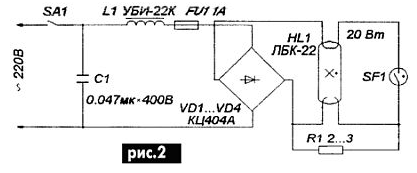In [1,2] describes the schema that allow you to extend the life of fluorescent lamps (LDS). They certainly deserve attention, attracted by its simplicity, availability and can be recommended for recurrence. But when we repeat these schemes you need to keep in mind that the filament is LDS, which remains "live", has an overload, because a blown filament is shunted “jumper wire".
This forced mode of operation of the lamp due reducing the resistance of the circuit of the incandescent filament twice leads to its rapid wear, and it fails. In addition, the scheme of "resuscitation", given in [2], requires additional installation of the starter button, so when the management of LDS using the wall switch, the problem arises where to place this release button to turn on the lamp installed on the ceiling?
In the scheme of “reanimation", which is shown in Fig.1, these disadvantages there is no.

As you can see from Fig.1, a blown filament LDS not shunted by a jumper, and wire resistor whose resistance is equal to the cold resistance of the filament. For lamps with a capacity of 20 and 30 watts (LBC, LBUT) this resistance is 2...3 Ohm. Wire the resistor R1 is made on the resistor type MO-0,25 10 ohms and is 2-3 turns of nichrome wire with a diameter of 0.15...0.2 mm.
As the resistor R1 is very convenient to use AC wire resistor type SP5-28A nominal 33 Ω or the like, choosing when setting up the magnitude of its resistance so that the filament is LDS not to overload (if the start it should be red or pink at a steady ignition lamp). When setting up the scheme must also take into account the recommendations [1], which provide confident ignition LDS.
In order to bring the work of LDS during her start to work with entire threads filament, consistent with a "cold" resistance of the resistor R1 include three parallel-connected incandescent bulb type 13,5 MN-0,18 (with voltage of 13.5 V and a current of 0.18 A). The current-voltage characteristic (CVC) of their such same as I-V curves of the filament LDS. Instead of these three light bulbs can be used one automotive lamp 12 In x 6 St
However, "intensive care unit" can be cases where to achieve normal operation LDS use the diagram to Fig.1 fails. Lamp lights up and blinks hard with a frequency of 25 Hz, despite all the tricks mentioned in [1]. This blinking persists and when removed the starter SF1 and accompanied by an increased heating of the throttle. This work lamps due to the fact that she moved in half-wave mode due to loss issue one of the electrodes, i.e., the lamp operates as a diode, passing current in one direction only, resulting in flowing through the inductor is constant component of the rectified current, which causes heat.
In this case, to ensure the normal work of the LDS directly from the mains AC fails. But to revive the lamp can and in this case, it can still work reliably, if we translate it on the current supply of one direction, combining it with the output half-wave rectifier.
In Fig.2 shows such the scheme of inclusion.

Lamp work under this scheme is similar to the work of the lamp in Fig.1 for except that it flows unidirectional current with a frequency of 100 Hz, with this whole filament serves as a cathode lamps, and damaged - of the anode.
As the diodes of the bridge VD4 VD1...you can use the build types KTS402 KTS405... at 600 V and a current of 1 A for LDS with a capacity of 20, 30, 40 and 65 watts. Very easy Assembly type CC that has a fuse holder.
Literature
Author: K. V. Kolomeitsev, Ivano-Frankivsk






